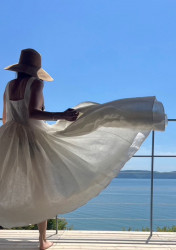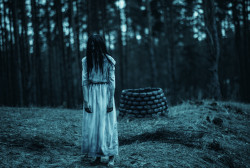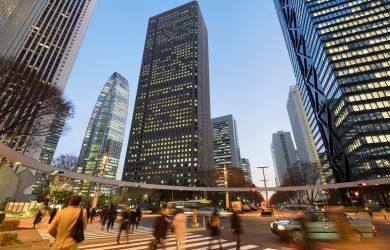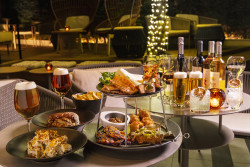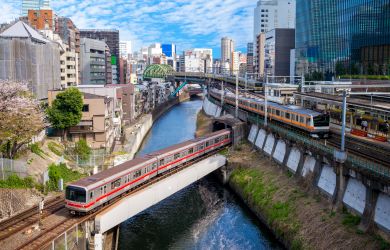
July 8, 2010
Makoto Aida + Hisashi Tenmyouya + Akira Yamaguchi
It’s nihonga, Jim, but not as we know it
By Metropolis
Originally published on metropolis.co.jp on July 2010

Makoto Aida, Blender, 2001, canvas, acrylic 290 x 210.5cm. Photos by C.B. Liddell.
The exhibition, featuring 18 works from three artists heavily influenced but not constrained by Japan’s nihonga traditions, is the latest offering at the Takahashi Collection, the art space created by Japan’s best known collector, Ryutaro Takahashi.
Although the works are daring, genre-confounding and even avant-garde in their retro nihonga way, this is not something entirely new. Back in 2006, the Museum of Contemporary Art Tokyo’s “From Nihonga to Nihonga” exhibition showcased several young artists who mixed traditional aesthetics and techniques with a modern sensibility. Then, last summer, the Ueno Royal Museum’s “Neoteny” show, sourced from Mr. Takahashi’s private collection, offered up an intriguing selection of contemporary art, including works like Makoto Aida’s Picture of an Air Raid on New York City (1996)—a beautifully-produced six-panel folding screen—and Giant Salamander (2003), both of which owed an obvious debt to nihonga.

Akira Yamaguchi, The Nine Aspects (detail), 2003, canvas, oil, 73 x 244cm
The three artists at this exhibit display different facets of what has been called a “Neo-Nihonga” movement. Akira Yamaguchi is the most conventional, using oil and canvas to mimic old Japanese screen and scroll paintings. His Flowers (2003) shows a broken tree sending out new shoots, the kind of subject matter you would expect from nihonga. It is only when you look closer that you notice that some of the twigs and branches are wired and hinged, giving the work a slightly sinister Westworld feel. Instead of nature, we sense a world contrived for some ulterior motive, whether to entertain or entrap. This trick of hiding modern technological elements inside what are ostensibly very traditional scenes is repeated in other works like The Nine Aspects (2003), where the steeds of the various samurai turn out to be motorbikes with horses’ heads.
The samurai spirit is also strong in the art of Hisashi Tenmyouya, although here it is mixed with elements of various subcultures, including yakuza, otaku and street. Tattoo Man (2002), an acrylic painting on gold-leaf-decorated wood, brings nihonga to a couple of demographics it bypassed, casting the TV superhero Ultraman as a gangster with geek appeal. Elsewhere, Tenmyouya takes motifs from graffiti and uses them for elaborately decorated works. Kill with a Single Blow, Special Attack Party (2000) mixes motorbike gang menace with the kind of Rimpa art flourishes associated with the Edo-period artist Ogata Korin.

Hisashi Tenmyouya, Tattoo Man, 2002, acrylic, gold leaf, wood, 59.8 x 42cm
The most interesting artist of the three is undoubtedly Makoto Aida, but some may find his art offensive. Chinese Food (War Picture Returns) (1999), a rather drab two-panel screen decorated with scattered pigs’ heads, may even be construed as racist, while DOG (Moon) (1996), a painting in Japanese mineral pigments of a beautiful naked girl with amputated limbs and a dog collar around her neck, shows an absence of the kind of chivalry that has allowed the women’s movement to make so much progress.
The least overtly “nihonga” of the three, Aida is a wild artistic spirit who creates without any fear or even awareness of moral considerations or political correctness. While sometimes this merely results in art that seems truculent and pointless, it also enables him to create truly shocking and astounding works like Blender (2001), a large painting that shows a food blender filled with thousands of tiny naked ladies, many of whom are in the process of being turned into a bloody pulp. Viewed up close, this work reminds us of some of the more nightmarish paintings by the great Spanish artist Francisco Goya.
Takahashi Collection
Makoto Aida, Hisashi Tenmyouya and Akira Yamaguchi. Various media. Until Aug 8, free (MS and under)/¥150 (HS, univ)/¥300 (adult). 1-1-2 Yurakucho, Chiyoda-ku. Tel: 03-6206-1890. Open Tue-Sun 11am-7pm, closed Mon. Nearest stn: Hibiya. www.takahashi-collection.com

